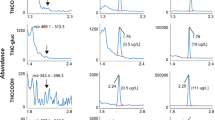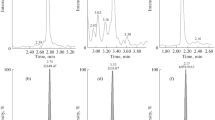Abstract
Despite efforts by legal authorities to control the abuse of synthetic cannabinoids, new derivatives have continually emerged on the market to circumvent regulations, and its abuse has become a threat to public health. Thus, development of analytical methods for confirming drug intake in biological fluids is essential to ensure effective drug control and to address further drug intoxication cases. Herein, a sensitive and reliable liquid chromatography–tandem mass spectrometry method was established and validated for the simultaneous determination of 37 synthetic cannabinoid metabolites, such as N-hydroxypentyl and carboxy metabolites, using 100 μl of urine. Urine specimens were treated by enzymatic hydrolysis and solid-phase extraction. Limits of detection for the evaluated drugs ranged from 0.1 to 1 ng/ml, and the linear range spanned from 0.25 or 1 to 100 ng/ml. Precision and accuracy bias were 1.4–12.1 % and −7.2–7.2 %, respectively. Matrix effects biases were in the range of 0.4 to 10.1 %, and extraction recoveries were 65–99 %. In addition, all analytes were stable under storage conditions of 4 °C and −20 °C for 14 days, and after three freeze–thaw cycles. The developed method was successfully applied to actual urine specimens obtained from synthetic cannabinoid users. The present method enabled simultaneous quantification of 37 synthetic cannabinoid metabolites, including their regioisomers, in urine in the field of clinical and forensic toxicology.


Similar content being viewed by others
References
Zuba D, Byrska B (2013) Analysis of the prevalence and coexistence of synthetic cannabinoids in “herbal high” products in Poland. Forensic Toxicol 31:21–30
Kikura-Hanajiri R, Uchiyama N, Kawamura M, Goda Y (2013) Changes in the prevalence of synthetic cannabinoids and cathinone derivatives in Japan until early 2012. Forensic Toxicol 31:44–53
Chung H, Choi H, Heo S, Kim E, Lee J (2014) Synthetic cannabinoids abused in South Korea: drug identifications by the National Forensic Service from 2009 to June 2013. Forensic Toxicol 32:82–88
Uchiyama N, Shimokawa Y, Kawamura M, Kikura-Hanajiri R, Hakamatsuka T (2014) Chemical analysis of a benzofuran derivative, 2-(2-ethylaminopropyl)benzofuran (2-EAPB), eight synthetic cannabinoids, five cathinone derivatives, and five other designer drugs newly detected in illegal products. Forensic Toxicol 32:266–281
Auwärter V, Dresen S, Weinmann W, Müller M, Pütz M, Ferreirós N (2009) ‘Spice’ and other herbal blends: harmless incense or cannabinoid designer drugs? J Mass Spectrom 44:832–837
Castaneto MS, Gorelick DA, Desrosiers NA, Hartman RL, Pirard S, Huestis MA (2014) Synthetic cannabinoids: epidemiology, pharmacodynamics, and clinical implications. Drug Alcohol Depend 144:12–41
Brents LK, Reichard EE, Zimmerman SM, Moran JH, Fantegrossi WE, Prather PL (2011) Phase I hydroxylated metabolites of the K2 synthetic cannabinoid JWH-018 retain in vitro and in vivo cannabinoid 1 receptor affinity and activity. PLoS One 6:e21917
Brents LK, Gallus-Zawada A, Radominska-Pandya A, Vasiljevik T, Prisinzano TE, Fantegrossi WE, Moran JH, Prather PL (2012) Monohydroxylated metabolites of the K2 synthetic cannabinoid JWH-073 retain intermediate to high cannabinoid 1 receptor (CB1R) affinity and exhibit neutral antagonist to partial agonist activity. Biochem Pharmacol 83:952–961
Dresen S, Ferreirós N, Pütz M, Westphal F, Zimmermann R, Auwärter V (2010) Monitoring of herbal mixtures potentially containing synthetic cannabinoids as psychoactive compounds. J Mass Spectrom 45:1186–1194
Gurney SMR, Scott KS, Kacinko SL, Presley BC, Logan BK (2014) Pharmacology, toxicology, and adverse effects of synthetic cannabinoid drugs. Forensic Sci Rev 26:53–78
Saito T, Namera A, Miura N, Ohta S, Miyazaki S, Osawa M, Inokuchi S (2013) A fatal case of MAM-2201 poisoning. Forensic Toxicol 31:333–337
Sasaki C, Saito T, Shinozuka T, Irie W, Murakami C, Maeda K, Nakamaru N, Oishi M, Nakamura S, Kurihara K (2015) A case of death caused by abuse of a synthetic cannabinoid N-1-naphthalenyl-1-pentyl-1H-indole-3-carboxamide. Forensic Toxicol 33:165–169
Arntson A, Ofsa B, Lancaster D, Simon JR, McMullin M, Logan B (2013) Validation of a novel immunoassay for the detection of synthetic cannabinoids and metabolites in urine specimens. J Anal Toxicol 37:284–290
Barnes AJ, Young S, Spinelli E, Martin TM, Klette KL, Huestis MA (2014) Evaluation of a homogenous enzyme immunoassay for the detection of synthetic cannabinoids in urine. Forensic Sci Int 241:27–34
Kneisel S, Auwärter V (2012) Analysis of 30 synthetic cannabinoids in serum by liquid chromatography-electrospray ionization tandem mass spectrometry after liquid-liquid extraction. J Mass Spectrom 47:825–835
Kneisel S, Speck M, Moosmann B, Corneillie TM, Butlin NG, Auwärter V (2013) LC/ESI-MS/MS method for quantification of 28 synthetic cannabinoids in neat oral fluid and its application to preliminary studies on their detection windows. Anal Bioanal Chem 405:4691–4706
Kim J, Park Y, Park M, Kim E, Yang W, Baeck S, Lee S, Han S (2015) Simultaneous determination of five naphthoylindole-based synthetic cannabinoids and metabolites and their deposition in human and rat hair. J Pharm Biomed Anal 102:162–175
Mazzarino M, de la Torre X, Botrè F (2014) A liquid chromatography-mass spectrometry method based on class characteristic fragmentation pathways to detect the class of indole-derivative synthetic cannabinoids in biological samples. Anal Chim Acta 837:70–82
Huppertz LM, Kneisel S, Auwärter V, Kempf J (2014) A comprehensive library-based, automated screening procedure for 46 synthetic cannabinoids in serum employing liquid chromatography-quadrupole ion trap mass spectrometry with high-temperature electrospray ionization. J Mass Spectrom 49:117–127
Simões SS, Silva I, Ajenjo AC, Dias MJ (2014) Validation and application of an UPLC-MS/MS method for the quantification of synthetic cannabinoids in urine samples and analysis of seized materials from the Portuguese market. Forensic Sci Int 243:117–125
Scheidweiler KB, Jarvis MJ, Huestis MA (2015) Nontargeted SWATH acquisition for identifying 47 synthetic cannabinoid metabolites in human urine by liquid chromatography-high-resolution tandem mass spectrometry. Anal Bioanal Chem 407:883–897
Sundström M, Pelander A, Angerer V, Hutter M, Kneisel S, Ojanperä I (2013) A high-sensitivity ultra-high performance liquid chromatography/high-resolution time-of-flight mass spectrometry (UHPLC-HR-TOFMS) method for screening synthetic cannabinoids and other drugs of abuse in urine. Anal Bioanal Chem 405:8463–8474
Kronstrand R, Brinkhagen L, Birath-Karlsson C, Roman M, Josefsson M (2014) LC-QTOF-MS as a superior strategy to immunoassay for the comprehensive analysis of synthetic cannabinoids in urine. Anal Bioanal Chem 406:3599–3609
Chimalakonda KC, Moran CL, Kennedy PD, Endres GW, Uzieblo A, Dobrowolski PJ, Fifer EK, Lapoint J, Nelson LS, Hoffman RS, James LP, Radominska-Pandya A, Moran JH (2011) Solid-phase extraction and quantitative measurement of omega and omega-1 metabolites of JWH-018 and JWH-073 in human urine. Anal Chem 83:6381–6388
Hutter M, Moosmann B, Kneisel S, Auwärter V (2013) Characteristics of the designer drug and synthetic cannabinoid receptor agonist AM-2201 regarding its chemistry and metabolism. J Mass Spectrom 48:885–894
Jang M, Yang W, Shin I, Choi H, Chang H, Kim E (2014) Determination of AM-2201 metabolites in urine and comparison with JWH-018 abuse. Int J Legal Med 128:285–294
Jang M, Shin I, Yang W, Chang H, Yoo HH, Lee J, Kim E (2014) Determination of major metabolites of MAM-2201 and JWH-122 in in vitro and in vivo studies to distinguish their intake. Forensic Sci Int 244:85–91
Peters FT, Drummer OH, Musshoff F (2007) Validation of new methods. Forensic Sci Int 165:216–224
Matuszewski BK, Constanzer ML, Chavez-Eng CM (2003) Strategies for the assessment of matrix effect in quantitative bioanalytical methods based on HPLC-MS/MS. Anal Chem 75:3019–3030
Viswanathan CT, Bansal S, Booth B, DeStefano AJ, Rose MJ, Sailstad J, Shah VP, Skelly JP, Swann PG, Weiner R (2007) Quantitative bioanalytical methods validation and implementation: best practices for chromatographic and ligand binding assays. Pharm Res 24:1962–1973
de Jager AD, Warner JV, Henman M, Ferguson W, Hall A (2012) LC-MS/MS method for the quantitation of metabolites of eight commonly-used synthetic cannabinoids in human urine–An Australian perspective. J Chromatogr B 897:22–31
Yanes EG, Lovett DP (2012) High-throughput bioanalytical method for analysis of synthetic cannabinoid metabolites in urine using salting-out sample preparation and LC-MS/MS. J Chromatogr B 909:42–50
Scheidweiler KB, Huestis MA (2014) Simultaneous quantification of 20 synthetic cannabinoids and 21 metabolites, and semi-quantification of 12 alkyl hydroxy metabolites in human urine by liquid chromatography-tandem mass spectrometry. J Chromatogr A 1327:105–117
Acknowledgments
This study was supported by funding from the National Research Foundation of Korea (NRF) of the Ministry of Science, ICT and Future Planning (NRF-2014M3A9A4049149), and from the National Forensic Service (2014-01).
Conflict of interest
There are no financial or other relation that could lead to a conflict of interest.
Author information
Authors and Affiliations
Corresponding author
Rights and permissions
About this article
Cite this article
Jang, M., Shin, I., Kim, J. et al. Simultaneous quantification of 37 synthetic cannabinoid metabolites in human urine by liquid chromatography-tandem mass spectrometry. Forensic Toxicol 33, 221–234 (2015). https://doi.org/10.1007/s11419-015-0265-x
Received:
Accepted:
Published:
Issue Date:
DOI: https://doi.org/10.1007/s11419-015-0265-x




